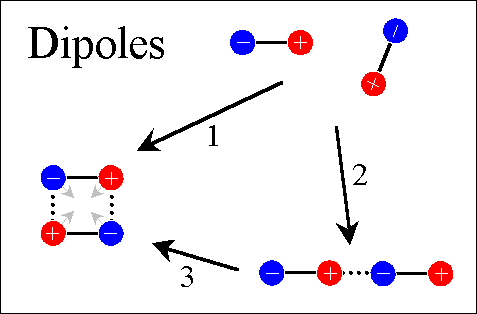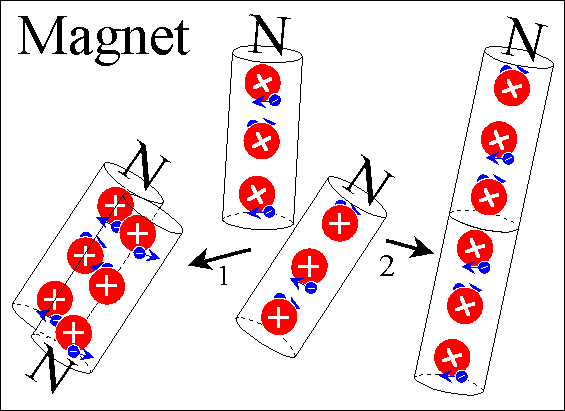
The Great Unifying Theory (Theory Of Everything, Weltformel) explains any
phenomena and predicts any processes. This allows assesment of single steps and
whole strategies of solutions to problems. The theory is:
The more similar two things are, the stronger is the mutual influence of
their behaviour.
This is only one of several possible expressions. Another was:
Two things
strive for gain of similarity and loss of differences and opposites.
Inhalt
1. Explanation of terms
2. Electric charge or dipole?
3. Molecular binding
4. "Magnetism"
5. "Magnetic field" of electric conductors
6. Conclusions
1. Explanation of terms
Similarity is made of corresponding (e.g. mass-mass), non-corresponding (e.g.
mass-magnetism) and opposite (e.g. matter-antimatter) properties of things.
Properties are all known and unknown qualitative and quatitative parameters
(e.g. mass, charge, position in time and space).
Two things can possess corresponding, non-corresponding and opposite properties
together.
Space and time are only two properties as others, in which two things are
similar (or different). All things belong to the Universe. Thus they always
have these properties.
stronger is a factor. Depending on the properties it can be either linear or
exponential.
mutual influence of their behaviour means that any change in one of the two things is accompanied by an equal
amount of change in the other. If the properties were
corresponding, the direction of change is the same (amplification). If they
were non-corresponding the thing without a property will gain it in the
direction the other has it. If they were opposite, they are annihilated.
2. Electric charge or dipole?
One of the most frequent objections to my theory is the repel of equal
charges. Therefore I will use especially this problem as an example of use.
Electric charge never emerges nor vanishes separate but as a couple of negative
und positive charges (electron/positron, electron/cation, anion/cation). Not
charge is the property but dipole.
Any dipole interacts with each other according to the Great Unifying Theory.
Dipoles strive for maximum local dipole strength.
Both poles are not bound to the special partner they emerged with. The rest of
the universe with opposite charge is the other pole with a local maximum at the
nearest. This is displayed in the bottom left configuration in figure 1.
Figure 1: Dipoles

3. Molecular binding
According to this model atoms are rotating dipoles. The most simple one is the
hydrogen atom. It spontaneously forms molecules under standard conditions. Why?
I claim that it ist the result of interacting dipoles as shon in figure 2,
striving for local maximum of strength.
Figure 2 looks a bit like the atom model of Bohr. But ist only means that the
basis of interaction are the dipoles, they interact in a plane and they rotate
in opposite directions with maxima as shown in the figure. It's easier drawn
than explained.
Figure 2: Molecular binding. Example: Hydrogen molecule.

A similar three-dimensional interaction might be the basis of the extreme
mechanical stability and optical properties of diamond.
4. "Magnetism"
Magnetism is based on moving dipoles. A magnetic rod expresses a northern and
southern pole because of an ordered movement of dipoles (usually termed as
movement of charges). In permanent magnetes this is based on interacting
dipoles in chrystal structure. In coils it is based on forced ordered movement
of dipoles.
Why magnetic northpoles are repelled by northpoles is illustrated in figure 3.
The positive and negative charges are extremely simplified charge centres
within the crystal structure of a permanent magnet.
Dipole direction and position are to take strictly for the simplification.
Figure 3: Magnetism

5. "Magnetic field" of electric conductors
Neighbouring parallele conductors with equally directed current attract each
other. Usually this is explained ba a ring-shaped magnetic field. But what are
"magnetic fields" and how do they interact?
If only movement of electrons was responsible for this, two electron beams in
vacuum also should attract each other. But first there ist a logical problem:
The electrons within the beams cannot know that they are moved. So they repel
as they do in electron clouds. And second this can be observed in electron
valves. Electron beams have to be focussed by influence of magnetic fields -
which are nothing else than moving dipoles, as mentioned before.
But why are electron beams focussed in conductors and do not move out? Simply
because of the dipole influence, e.g. between moving negative charges
(electrons) and the positively charged nuclei of metal grids of cables.
In figure 4 "bound" electrons of the conductor are not shown. Different to the
circular change of dipoles in figure 3 the sum change is linear.
Figure 4: Metal conductor

6. Conclusions
Fields do not exist. Any interaction is based on similarity.
Interaction occurs at infinite speed.
Information can be transmitted through space and time. Prophecies, premonition
and telepathy are possible.
Electric and magnetic "fields" have the same basis: dipoles.
God does exist.
I know, that my conclusions are a bit provocative. Unfortunately, further
explanation does only exist in a german version.
09.02.2003
Torsten Reichelt
Zur Hauptseite Zur Textübersicht
